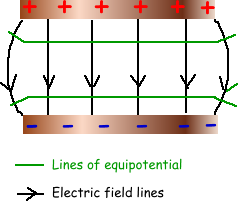    |
||||

Electric Intensity or Electric Field Strength |
||||
|
Electric field strength at a point in an electric field is the force acting on unit positive charge placed at that point. It is a vector (forces are!) - so it will have magnitude and direction. The units are N/C or V/m - N/C is usually used for field strengths around point charges (in radial fields) and V/m for uniform fields (between capacitor plates etc.) The same is true with the electric field. F = EQ, so for a given charge the greater the electric intensity (or electric field strength) the greater the force will be on that charged particle We often have to do calculations on the acceleration of charged particles within an electric field. We therefore have to use the above equation to determine the force acting and then use F=ma to determine the acceleration that will result.
What is the electric field strength (or intensity) at point X? When finding the electric field strength at a point in a field that is caused by several charges it is necessary to find the electric intensity of each charge at that point and then add the vector values. Using the equation:
magnitude of E for both vectors is = (5.0 x 10-6)/(4
From the sketch you can see that horizontally they both have a direction to the right but that they oppose each other vertically The vertical components cancel but the net electric intensity is double a single horizontal component. Therefore the net E = 2 x 2.79 x 103 x cos 60o N/C to the right = 2,800 N/C to the right (2 sig figs) The AQA syllabus likes you to say Vm-1 rather than N/C When finding the electric field strength between capacitor plates you need to be aware that there is UNIFORM field strength - so the 'd' is the distance between the plates and 'V' is the potential difference between those plates - the intensity is the same at all points between those plates so any acceleration produced will be uniform - as the force produced (and therefore the acceleration) will be constant. Practical note: 'edge effects' means that near the edge of the plates the uniformity of field is disrupted.
|
||||
 |
||||


 The intensity of the electric field or the electric field strength can be thought of as the gradient of the field
The intensity of the electric field or the electric field strength can be thought of as the gradient of the field Sample Question:
Sample Question:  But to find the net effect of them we need to sketch a diagram to help us understand the vector nature of the electric intensities.
But to find the net effect of them we need to sketch a diagram to help us understand the vector nature of the electric intensities.


